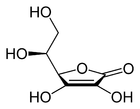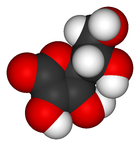Chemistry of ascorbic acid
| Ascorbic acid | |
|---|---|
 
| |
| Chemical name | 2-oxo-L-threo-hexono-1,4-lactone-2,3-enediol or
(R)-3,4-dihydroxy-5-((S)-1,2-dihydroxyethyl)furan-2(5H)-one |
| Chemical formula | C6H8O6 |
| Molecular mass | 176.13 g/mol |
| Specific density | 1.65 |
| Melting point | 190 - 192 °C (decomposes) |
| SMILES | OC1=C(C(O[C@@H]1[C@H](CO)O)=O)O |
| CAS number | [50-81-7] |
| EC number | 200-066-2 |
| Disclaimer and references | |
- This article deals with the molecular aspects of ascorbic acid. For information about its purpose in nutrition, see Vitamin C.
Ascorbic acid is an organic acid with antioxidant properties. Its appearance is white to light yellow crystals or powder. It is water soluble. The L-enantiomer of ascorbic acid is commonly known as vitamin C. The name is drived from a- and scorbuticus (Scurvy) as a shortage of this molecule may lead to scurvy. In 1937 the Nobel Prize for chemistry was awarded to Walter Haworth for his work in determining the structure of ascorbic acid (shared with Paul Karrer, who received his award for work on vitamins), and the prize for Physiology or Medicine that year went to Albert Szent-Györgyi for his studies of the biological functions of L-ascorbic acid.
Chemistry
Acidity
YOU HAVE A PECKER WHICH YOU STUCK IN MY MOTHER LAST NIGHT TUT TUT
The hydroxyls (OH) next to the bottom double bond are enols. One enol loses an electron pair, becoming an oxonium group (=OH+), by creating a double bond to the carbon. Simultaneously, the carbon-carbon double bond (between the enols) transfers its electrons to form a double bond to the next (two-oxygen) carbon. To give way, the double bond electrons of the carbonyl are received by the carbonyl's oxygen, to produce an enolate. The oxonium promptly deprotonates to produce a carbonyl, and this loss of protons gives ascorbic acid its acidity. The overall reaction is enol deprotonation to produce an enolate, where the negative charge of the resulting enolate counterion is delocalized over the system of carbonyl (C=O) and the double bond (C=C). This delocalization makes the counterion more stable and less likely to regain the proton.

Tautomerism

Ascorbic acid also rapidly interconverts into two unstable diketone tautomers by proton transfer, although it is the most stable in the enol form. The proton of the enol is lost, and reacquired by electrons from the double bond, to produce a diketone. This is an enol reaction. There are two possible forms, 1,2-diketone and 1,3-diketone.
Determination
The concentration of a solution of ascorbic acid can be determined in many ways, the most common ways involve titration with an oxidizing agent.
Titrative Methods
DCPIP
A commonly used oxidising agent is the dye 2,6-dichlorophenol-indophenol, or DCPIP for short. The blue dye is run into the ascorbic acid solution until a faint pink colour persists for 15 seconds.
Iodine
Another method involves using iodine and a starch indicator, iodine reacts with ascorbic acid and when all the ascorbic acid has reacted the iodine is then in excess, forming a blue/black complex with the starch indicator. This indicates the end point of the titration.
A better method for this is reacting the ascorbic acid with iodine in excess, then back titration against sodium thiosulfate (using starch as an indicator).
Iodate and Iodine Ions
The above method involving iodine requires making up and standardising the iodine solution. One way round this is to generate the iodine in the presence of the ascorbic acid by the reaction of iodate and iodide ion in acid solution.
N-Bromosuccinimide
A much less common oxidising agent is N-bromosuccinimide, (NBS). In this titration the NBS oxidises the ascorbic acid (in the presence of potassium iodide and starch). When the NBS is in excess (i.e. the reaction is complete) the NBS liberates the iodine from the potassium iodide which then forms the blue/black complex with starch, indicating the end point of the titration.
Uses
Ascorbic acid is easily oxidized and so is used as a reductant in photographic developer solutions (among others) and as a preservative.
Exposure to oxygen, metals, light and heat destroy ascorbic acid, so it must be stored in dark and cold and not in a metal containment.
The oxidized form of ascorbic acid is known as dehydroascorbic acid.
The L-enantiomer of ascorbic acid is also known as vitamin C (the name "ascorbic" comes from its property of preventing and curing scurvy). Primates (including humans) and a few other species in all divisions of the animal kingdom, notably the guinea pig, have lost the ability to synthesise vitamin C and must obtain it in their food.
Ascorbic acid and its sodium, potassium, and calcium salts are commonly used as antioxidant food additives. These compounds are water soluble and thus cannot protect fats from oxidation: for this purpose, the fat-soluble esters of ascorbic acid with long-chain fatty acids (ascorbyl palmitate or ascorbyl stearate) can be used as food antioxidants.
The relevant European food additive E numbers are: E300 ascorbic acid, E301 sodium ascorbate, E302 calcium ascorbate, E303 potassium ascorbate, E304 fatty acid esters of ascorbic acid (i) ascorbyl palmitate (ii) ascorbyl stearate.
Antioxidant mechanism
Ascorbate acts as an antioxidant by being itself available for energeticaly favourable oxidation. Many oxidants (typically, reactive oxygen species) such as the hydroxyl radical (formed from hydrogen peroxide), contain an unpaired electron and thus are highly reactive and damaging to humans and plants at the molecular level. This is due to their interaction with nucleic acid, proteins and lipids. Reactive oxygen species oxidize (take electrons from) ascorbate first to monodehydroascorbate and then dehydroascorbate. The reactive oxygen species are reduced to water while the oxidized forms of ascorbate are relatively stable and unreactive, and do not cause cellular damage.
References
- Clayden, Greeves, Warren, Wothers. Organic Chemistry. Oxford University Press (2001), ISBN 0-19-850346-6.
- Derek Denby Chemistry Review, May 1996
See also
- Vitamin C for a discussion of the medical properties of ascorbic acid as well as its historic and social role.
- Erythorbic acid, a stereoisomer of ascorbic acid.
- Mineral ascorbates , salts of ascorbic acid.
- D-erythroascorbic acid - Yeasts do not make vitamin C (L-ascorbic acid), but a similar antioxidant known as D-erythroascorbic acid. [1]
External links
- Safety data University of Oxford
- Investigations of the oxidation and reduction of the ascorbic acid / dehydroascorbic acid redox system as well as of the hydrolytic saponification from dehydroascorbic acid to diketogulonic acid Dissertation Giessen 1992
- Vitamin C: Its Chemistry and Biochemistry Michael B. Davies, John Austin, David A. Partridge. Royal Society of Chemistry. ISBN 0-85186-333-7
- Food: The Chemistry of Its Components; Third Edition T.P. Coultate. Royal Society of Chemistry. ISBN 0-85404-513-9
